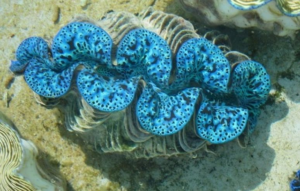Scientists at the University of California have accidentally found a way to work towards reflective colour displays – in the shells of giant clams.
Giant clams, which live in the Pacific and Indian oceans, have a symbiotic relationship with algae living in their shells. The clams take in carbohydrates produced by the algae’s photosynthesis, while the algae takes nutrients from the clams’s waste.
A collection of iridescent cells, just inside the edge of the clams’ shells, can be found at the interface between the clam and the algae. These cells produce a wide array of colours, include blues, greens, golds and – more rarely – white. The teams research focuses on the ways that the clam collects light to power the algae’s photosynthesis.
To understand the rarer white colouration, the team studied two types of giant clam: Tridacna maxima and Tridacna derasa. These species produce the white in different ways. Tridacna maxima uses tight clusters of individually coloured cells; Tridacna derasa uses multicoloured individual cells, which appear white on a macroscopic scale.
Despite the different methods, both sub-species create white by mixing clusters of colours; much like electronic displays mix red, green and blue to create white. However, the clams’ method is totally reflective, while most electronic displays must generate light.
“If we could create and control structures similar to those that generate colour in the clams, it might be possible to build colour-reflective displays that work with ambient light sources such as sunlight or normal indoor lighting,” said Amitabh Ghoshal, first author of the study. “Producing colour the way giant clams do could lead to smartphone, tablet and TV screens that use less power and are easier on the eyes.”
Analyst Comment
This is not the first time, even in the past year, that nature has provided an impetus for research into reflective displays: see A Natural Transparent Display for information on MIT’s work with the blue-rayed limpet. (TA)

